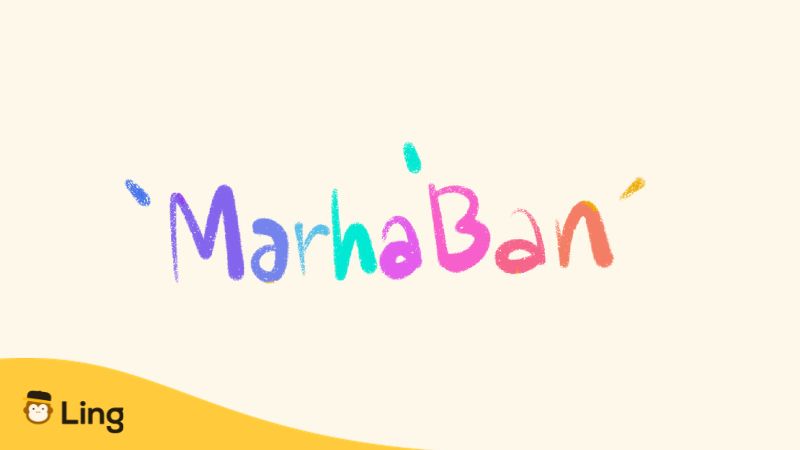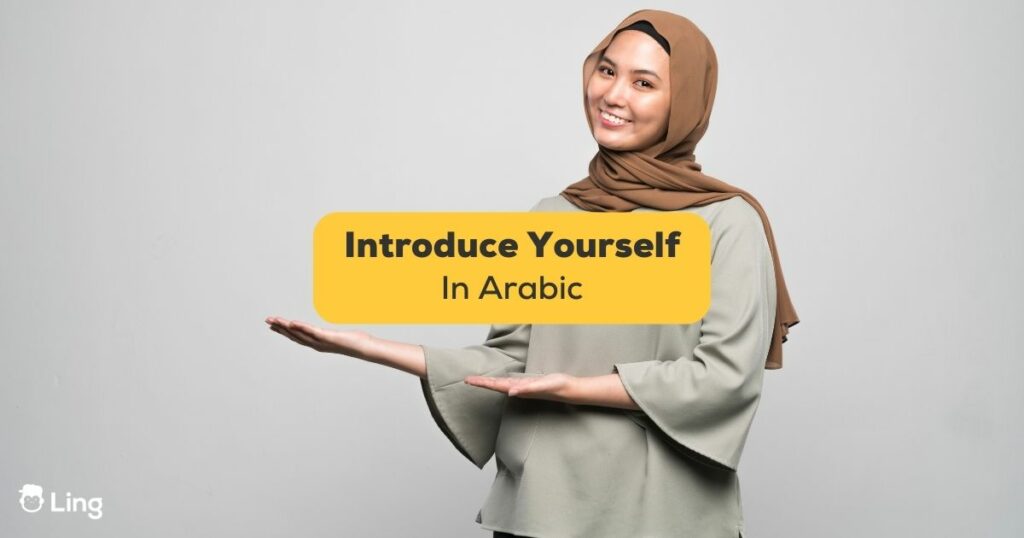Since meeting new people and communicating is the ultimate reason for learning a foreign language – the Arabic language in our case – the first thing you should learn is to introduce yourself in Arabic. Whether you’re planning to visit an Arabic-speaking country or just want to connect with native Arabic speakers, self-introduction is a valuable skill.
In this article, you will learn the art of self-introduction in Arabic, allowing you to make a positive impression and foster friendly connections with Arab people.
Introduce Yourself In Arabic
Self-introduction is important in Arab culture, as it plays a significant role in establishing relationships, demonstrating respect, and conveying important information. Let’s learn how to introduce yourself in Arabic in just eight lines!

1. Hello!
Like many other languages, there is not a single way of greeting someone with a hello. Below are the two most common Arabic greetings to say hello.
Peace Be Upon You – As-salamu Alaykum – السلام عليكم
This phrase is the most universal Arabic greeting recognized by both Arab and Muslim communities. It means “peace be upon you“. When someone greets you with “As-salamu alaykum,” you should respond with “Wa alaykum as-salam” (وعليكم السلام), which means “and upon you be peace.” This greeting exchange can be used in both formal and informal settings.
Hello – Marhaban – مرحبا
This one is a more casual way of greeting someone. It’s widely used in everyday conversations, perfect for initial encounters or friendly interactions. It’s a warm and inviting greeting, similar to saying “hello” in English.
If you want to greet a group at once, go for “As-salamu alaykum” instead of “marhaban” as it’s not very appropriate for formal gatherings.
2. What’s Your Name?
When someone asks you your name in Arabic, you can reply in the following ways.
My Name Is … – Ismi (Your Name) – … اسمي
When someone asks what your name is, “Ma ismuk?” (ما اسمك؟), you can respond with “Ismi (your name). It means “My name is (…).”
I am … – Ana – … أنا
You can further personalize your introduction by using the word “Ana” ( أنا ), which means “I am.” This way, you let others know that you are introducing yourself.
What Is Your Name? – Ma Ismuk? – ما اسمك؟
To engage in a conversation, you should ask about the other person as well. You can say, “Ma ismuk?” (ما اسمك؟), which means “What is your name?”
When asking a male:
- What’s your name? – Mā ismuk? (ما اِسْمُك؟)
When asking a female:
- What’s your name? – Ma ismuki? (ما اِسْمُكِ؟)

3. Where Are You From?
You further the conversation by asking someone where they come from.
I’m From … – Ana Min (Place) – … أنا من
When someone is curious about where you are from, they ask, “Min ayyi baladin ‘ant?” (من أي بلد أنت؟). To answer this question, you should respond by saying, “Ana min (place).”
In English, only a few countries are written with a definite article. In Arabic, however, almost half of all countries in the world are written with a definite article. For example:
- The Japan – Al-yābān (اليونان)
- The Greece – Al-yūnān (اليابان)
4. Where Do You Live?
Want to ask someone where they are living currently? Here is how you do it.
Where Do You Live? – Ayna Ta’eesh? – أين تعيش؟
To respond to the question “Ayna ta’eesh?” meaning “Where do you live?” in Arabic, you should answer by giving the name of your country or city:
I live in (city or country) – ‘aeish fi (city or country) – … أعيش في
5. How Old Are You?
Asking someone’s age might not be considered polite but sometimes, you have no choice but to ask this question. Here is how you do it in Arabic.
How Old Are You? – Kam Omruk? – كم عمرك؟
To tell your age in Arabic, you can use this pattern omri + number + sana. For example, “omri talateen sana” (عمري ثلاثون سنة) which means “I’m 30 years old.”

6. What Do You Do For A Living?
How do you ask someone about their job or professional life in the Arabic language? Here’s how!
What Do You Do For A Living? – Maatha Ta’mal Litaksib Quwt Yawmik? – ماذا تعمل لتكسب قوت يومك؟
In Arabic, to ask, “What do you do for a living?” you can say “Maatha ta’mal litaksib quwt yawmik?”, which translates to “What do you do to earn your daily bread?” This is a common phrase to ask about someone’s occupation or profession in Arabic.
To respond to the question, you can use these phrases:
- I am a … – Ana (your occupation) – … أنا
- I work in the field of … – A’mal fi majal (your field) – … أعمل في مجال
7. What Are Your Hobbies?
Enquiring about hobbies and interests is a good way to carry forward a conversation, especially when you are meeting someone new. Here is how you can ask this question in Arabic.
What Are Your Hobbies? – Ma Hi Hiwayatika? – ما هي هواياتك؟
When we start getting to know someone, we are likely to wonder what they enjoy doing as a hobby in their free time. So, when someone asks you, “ma hi hiwayatika?” you can respond by using various phrases. For example:
- One of my hobbies is reading – wahidatun min hiwayati hi al-qiraʾah – واحدة من هواياتي هي القراءة
- I enjoy listening to music – ‘astamtiʿu bisamaʿi al-musiqa – أستمتع بسماع الموسيقى
- I like singing – ʾanā ʾuḥibbu al-ġināʾ – أنا أحب الغناء

8. It’s Nice To Meet You!
End the conversation with this polite sentence.
Nice To Meet You! – Tasharrafna – تشرفنا
You can use this phrase to politely express you’re pleased to meet someone. It actually means, “It was an honor.”
It’s Nice To Meet You – Saʿidtu Biliqaʾik – سعدت بلقائك
You can also use this phrase when you meet with someone for the first time. It translates to “I am delighted to meet you.”
Learning how to introduce yourself in Arabic is a gateway to building relationships, understanding culture, and experiencing the warmth of Arabic-speaking communities. By mastering the art of greetings and self-introduction, you open the door to meaningful connections and enriching experiences.
Start Learning Arabic With Ling!
If you want to learn Arabic as a new language and are looking for a comprehensive language-learning app, check out the Ling app now!
The Ling app is a language learning app designed to teach a foreign language from scratch to the advanced level. It contains various interactive exercises, such as practicing Arabic script and learning new Arabic words in context. It even has an AI chatbot to speak Arabic as you keep learning. The Ling app offers you everything to enhance the four primary language skills.
Don’t forget to visit Ling’s Arabic blog for weekly articles covering topics related to this language and culture!
So, don’t wait up and head to the App Store or Play Store to download the Ling app now!



































































